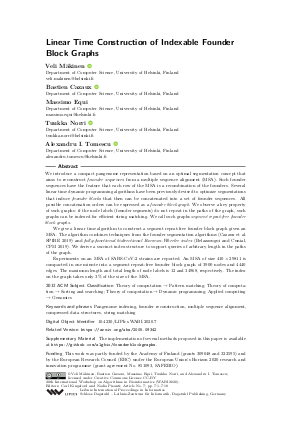@InProceedings{makinen_et_al:LIPIcs.WABI.2020.7,
author = {M\"{a}kinen, Veli and Cazaux, Bastien and Equi, Massimo and Norri, Tuukka and Tomescu, Alexandru I.},
title = {{Linear Time Construction of Indexable Founder Block Graphs}},
booktitle = {20th International Workshop on Algorithms in Bioinformatics (WABI 2020)},
pages = {7:1--7:18},
series = {Leibniz International Proceedings in Informatics (LIPIcs)},
ISBN = {978-3-95977-161-0},
ISSN = {1868-8969},
year = {2020},
volume = {172},
editor = {Kingsford, Carl and Pisanti, Nadia},
publisher = {Schloss Dagstuhl -- Leibniz-Zentrum f{\"u}r Informatik},
address = {Dagstuhl, Germany},
URL = {https://drops.dagstuhl.de/entities/document/10.4230/LIPIcs.WABI.2020.7},
URN = {urn:nbn:de:0030-drops-127961},
doi = {10.4230/LIPIcs.WABI.2020.7},
annote = {Keywords: Pangenome indexing, founder reconstruction, multiple sequence alignment, compressed data structures, string matching}
}

 Creative Commons Attribution 3.0 Unported license
Creative Commons Attribution 3.0 Unported license



















